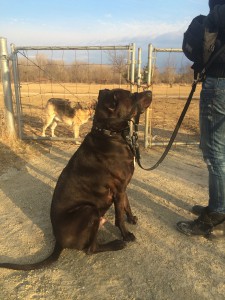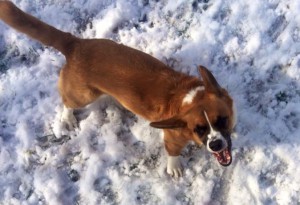Working as a behavior consultant for fearful, reactive, and aggressive dogs, I often hear new clients express unnecessary concerns or beliefs about their dog’s behavior based on information that is outdated or just plain wrong! My hardworking clients often deal with pressure from their friends or family that believe these myths, which makes the training process harder for everyone. Here are the top four myths I’ve heard:
1.) “That dog attacked a dog/cat, next it will be a child!”
Aggression toward other animals and aggression toward humans are not inherently related! Just think about it for a moment; there are breeds of dog bred for hunting foxes, raccoons, even wild boar… and they do so without ever turning on the hunters! Dogs do not equate humans with other animals (even dogs) and aggression in dogs almost always has very specific triggers. Ask anyone who has lived with a dog that overreacts to other dogs out on walks – those same dogs often show little to no aggression with passing humans. There is no reason to assume that dogs displaying dog or animal aggression will be also be triggered by humans.
2.) “He’s aggressive because he’s dominant/thinks he’s ‘alpha!’”
Many years ago, it was believed that dogs misbehaved because they were trying to climb the household hierarchy, and that this problem could be solved by physically and mentally dominating the dog. We now understand that most aggression in dogs is simply an emotion response. Most dogs show aggression or reactivity because they are scared, panicked, over-stimulated, or even frustrated. Some aggression is also related to unsatisfied genetic instinct. While addressing the dog-human relationship and household structure is ALWAYS important in these cases, what most aggressive dogs need is step-by-step training to help them deal with their negative emotions and learn a new way of responding to their triggers.3.) “Once a dog bites for any reason, he’ll do it again without warning!”
I read a heartbreaking story in which a woman’s beloved Basset Hound bit a mail carrier on the leg. The woman’s vet told her the dog could not be trusted around her family and advised that she euthanized him. This poor dog had no history of ever biting his family or even visitors! It’s very likely he was acting on territorial instinct and treating the mail carrier as a threat. This could have been worked through using training, and has NO inherent bearing on how the dog behaves toward his family! Unless a dog is genuinely mentally unstable (this happens but is rare), their triggers can be predicted and worked through!
4.) “This time it was just a nip, but next time it could be someone’s throat!”
It’s important to understand that dogs have extremely fine control of their mouths! In a way that is similar to our hands, a dog can deliver an air snap, a warning nip, or a crushing bite – just as we can touch, slap, punch, or choke someone. When a dog air snaps or even bites without causing serious injury, it’s not a lucky accident! The dog is trying to deliver a warning without causing harm.We refer to this trait as “bite inhibition.” While bite force can absolutely escalate if the problem is not addressed or if the dog is further threatened, it’s important to understand that not all bites are created equal. Dogs that intend to do harm will do so – they don’t waste time with little warning snaps or soft bites. If your dog snaps, nips, or bites without causing harm, you definitely need to get some help before things escalate, but it doesn’t mean you’ve got a killer on your hands!
Remember, aggression in dogs is trigger-specific. It happens for a reason, and those reasons can and should be addressed with professional help! Never let outdated or incorrect information color your view of your beloved dog if you’re struggling with aggression issues.

- How to Play With Your Dog: Part 1
- It Sounded Terrible!
- Voice Control
- I've Got This Feeling
- 4 Myths on Aggression in Dogs
- Doomed to Fail: Thoughts on "Padi"
- Welcome to Problem Solved! Dog Training
- Reducing Dog Stress During Christmas
- An Unexpected Litter, Puppy Expectations
- Behavior Intervention is Born
- Delaware - Where it All Started


